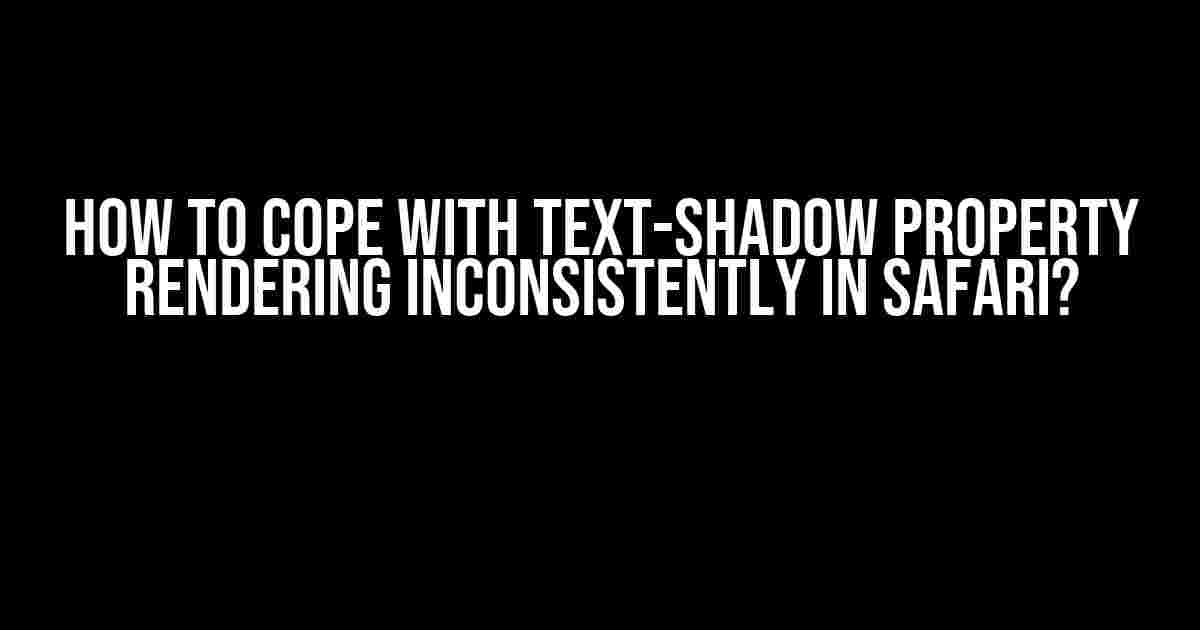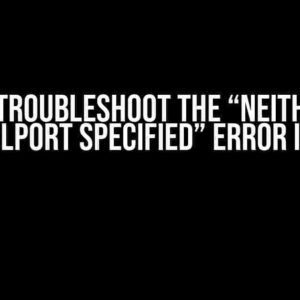Welcome to the frustrating world of Safari’s text-shadow property rendering inconsistencies! You’re not alone in this struggle. Many developers have faced this issue, and it’s time to take matters into our own hands. In this article, we’ll dive into the reasons behind this problem, explore the possible causes, and most importantly, provide you with actionable solutions to conquer this pesky issue once and for all.
What’s the Deal with Text-Shadow in Safari?
The text-shadow property is a CSS property that adds a shadow effect to text elements. Sounds simple, right? Well, in theory, it should be. However, Safari users might notice that the text-shadow property is rendering inconsistently, leading to a poor user experience. But why does this happen?
Inconsistencies in text-shadow rendering can occur due to various reasons, including:
- Browser-specific rendering engines
- Inadequate CSS syntax or formatting
- Conflicting CSS properties or rules
- Rendering issues related to font size, family, or style
- Performance-related problems, such as GPU acceleration
Identifying the Culprit: Safari’s Rendering Engine
Safari uses the WebKit rendering engine, which is known to have some quirks when it comes to text rendering. One of the main reasons for text-shadow inconsistencies is the way WebKit handles font rendering. Unlike Chrome, which uses the Blink rendering engine, Safari’s WebKit engine can lead to differences in how CSS properties are applied to text elements.
Another contributing factor is Safari’s graphics processing unit (GPU) acceleration. While GPU acceleration is meant to improve performance, it can sometimes cause rendering issues, including text-shadow inconsistencies.
Solutions to Tame the Safari Text-Shadow Beast
Fear not, dear developer! We’ve got a plethora of solutions to help you tame the Safari text-shadow property rendering beast. Here are some tried-and-tested methods to get you started:
Solution 1: Use the -webkit Prefix
One of the simplest ways to tackle text-shadow inconsistencies is to add the -webkit prefix to your CSS code. This prefix is specific to WebKit-based browsers, including Safari.
.text-shadow {
text-shadow: 2px 2px 4px rgba(0, 0, 0, 0.5); /* standard property */
-webkit-text-shadow: 2px 2px 4px rgba(0, 0, 0, 0.5); /* add the -webkit prefix */
}
By adding the -webkit prefix, you’re essentially telling Safari to use its own rendering engine to apply the text-shadow property. This can help resolve rendering inconsistencies and ensure a consistent look across different browsers.
Solution 2: Adjust Font Rendering
Font rendering can greatly impact the way text-shadows are displayed. Try adjusting font properties, such as font-size, font-family, or font-weight, to see if it makes a difference.
.text-shadow {
font-size: 18px; /* adjust font size */
font-family: Arial, sans-serif; /* try a different font family */
font-weight: bold; /* experiment with font weight */
text-shadow: 2px 2px 4px rgba(0, 0, 0, 0.5);
}
Remember, it’s essential to test and iterate on different font properties to find the perfect combination that works for your specific use case.
Solution 3: Use a Text-Shadow Generator
If you’re struggling to get the text-shadow property to work consistently across different browsers, consider using a text-shadow generator tool. These tools can help you create the perfect text-shadow effect without worrying about the underlying CSS syntax.
| Tool | Description |
|---|---|
| Text-Shadow Generator by CSSmatic | A simple online tool to generate text-shadows with customizable options. |
| Shadowgenerator by WebKit | A WebKit-specific tool to generate text-shadows with precise control over shadow properties. |
Solution 4: Apply Text-Shadow to a Wrapper Element
In some cases, applying the text-shadow property to a wrapper element instead of the text element itself can resolve rendering inconsistencies. This method can be particularly useful when dealing with complex layouts or nested elements.
.wrapper {
text-shadow: 2px 2px 4px rgba(0, 0, 0, 0.5);
}
.text-element {
/* no text-shadow property needed here */
}
Solution 5: Use a Fallback or Polyfill
If all else fails, you can use a fallback or polyfill to ensure a consistent text-shadow effect across different browsers. A polyfill is a piece of code that replicates the behavior of a newer CSS property in older browsers.
/* fallback for older browsers */
.text-shadow {
text-shadow: none; /* reset text-shadow */
filter: dropshadow(color=rgba(0, 0, 0, 0.5), offx=2, offy=2); /* fallback for older browsers */
}
/* polyfill for newer browsers */
.text-shadow {
text-shadow: 2px 2px 4px rgba(0, 0, 0, 0.5);
}
Remember to test your fallback or polyfill solution thoroughly to ensure it works as intended across different browsers and devices.
Conclusion
Inconsistencies in text-shadow rendering can be frustrating, but with the right techniques and solutions, you can tame the Safari text-shadow beast and ensure a consistent user experience across different browsers. By using the -webkit prefix, adjusting font rendering, leveraging text-shadow generators, applying text-shadow to wrapper elements, or using fallbacks or polyfills, you’ll be well-equipped to handle even the most stubborn text-shadow issues.
Remember, as a developer, it’s essential to stay up-to-date with the latest browser quirks and rendering issues. By sharing knowledge and best practices, we can create a better web development community that’s equipped to tackle any challenge that comes our way.
So, go ahead and conquer the world of text-shadows in Safari! Your users will thank you, and so will your sanity.
Additional Resources
For further learning and troubleshooting, check out these additional resources:
Happy coding, and may the text-shadow force be with you!
Frequently Asked Question
Got a headache from text-shadow rendering inconsistently in Safari? Don’t worry, we’ve got you covered!
Why does text-shadow property render inconsistently in Safari?
Safari’s rendering engine, WebKit, has some quirks when it comes to text-shadow. It’s not entirely a bug, but more of a rendering nuance that can be resolved with some clever workarounds.
How can I fix text-shadow rendering issues in Safari?
One way to fix this issue is to add `-webkit-transform: translateZ(0)` to the element with the text-shadow property. This forces Safari to use the GPU for rendering, which can improve performance and consistency.
Will using `-webkit-transform: translateZ(0)` affect other browsers?
Don’t worry, this fix is Safari-specific! Other browsers won’t be affected by this property, so you can use it safely without compromising compatibility.
Are there any other workarounds for text-shadow rendering issues in Safari?
Yes, another approach is to add `filter: blur(0)` to the element. This can also help Safari render text-shadow correctly. However, be cautious when using this method, as it might affect other CSS properties.
Is there a way to detect Safari rendering issues programmatically?
You can use JavaScript to detect Safari’s browser agent and apply the necessary workarounds. However, a more elegant approach is to use feature detection libraries like Modernizr to detect CSS support and adjust your styles accordingly.






